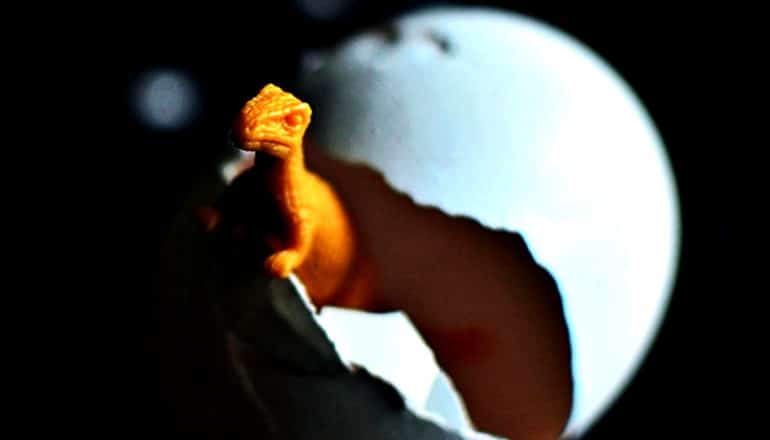
Dinosaurs were warm-blooded, according to a new technique that analyzes the chemistry of dinosaur eggshells.
“Dinosaurs sit at an evolutionary point between birds, which are warm-blooded, and reptiles, which are cold-blooded. Our results suggest that all major groups of dinosaurs had warmer body temperatures than their environment,” says lead author Robin Dawson, a postdoctoral research associate at the University of Massachusetts-Amherst who conducted the research while a doctoral student in geology and geophysics at Yale University.
The researchers tested eggshell fossils representing three major dinosaur groups, including ones more closely related to birds and more distantly related to birds.

The testing process is called clumped isotope paleothermometry. It is based on the fact that temperature determines the ordering of oxygen and carbon atoms in a fossil eggshell. Once you know the ordering of those atoms, the researchers say, you can calculate the mother dinosaur’s internal body temperature.
For example, eggshells of a Troodon, a small, meat-eating theropod, tested at 38 degrees, 27 degrees, and 28 degrees Celsius (or 100.4, 80.6, and 82.4 degrees Fahrenheit). Eggshells from the large, duck-billed dinosaur Maiasaura yielded a temperature of 44 degrees Celsius (111.2 degrees Fahrenheit). Both the Troodon and Maiasaura eggshells were from Alberta, Canada.
Meanwhile, fossilized dinosaur eggs from the oospecies (a species classification limited to dinosaur eggs) Megaloolithus, from Romania, tested at 36 degrees Celsius (96.8 degrees Fahrenheit).
The researchers conducted the same analysis on cold-blooded invertebrate shells in the same locations as the dinosaur eggshells. This helped the researchers determine the temperature of the local environment—and whether dinosaur body temperatures were higher or lower.
Dawson says the Troodon samples were as much as 10 Celsius degrees (50 degrees Fahrenheit) warmer than their environment, the Maiasaura samples were 15 Celsius degrees warmer (59 degrees Fahrenheit), and the Megaloolithus samples were 3-6 Celsius degrees (37.4-42.8 degrees Fahrenheit) warmer.
“What we found indicates that the ability to metabolically raise their temperatures above the environment was an early, evolved trait for dinosaurs,” Dawson says.
The findings may have other implications, as well, according to the researchers. For example, the study shows that a dinosaur’s body size and growth rate is not necessarily a good indicator of body temperature. The researchers further says their findings might add to the ongoing discussion about the role of feathers in early bird evolution.
“It’s possible that dense feathers were primarily selected for insulation, as body size decreased in theropod dinosaurs on the evolutionary pathway to modern birds,” Dawson says. “Feathers could have then later been co-opted for sexual display or flying.”
The study appears in the journal Science Advances.
Support for the research came from Yale, the Isaac Newton Trust, and the UK Research and Innovation Future Leaders Fellowship, the Sloan Research Fellowship, the Natural Sciences and Engineering Research Council Discovery Grant, and the Israel Science Foundation.
Source: Yale University
The post Eggshells indicate dinosaurs were warm-blooded appeared first on Futurity.
from Futurity https://ift.tt/2u97xpr
No comments:
Post a Comment